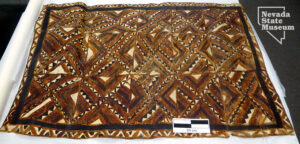May Curator’s Corner
Sadly, this is the second year that we had to cancel the Museum’s annual Lei Day event; however, in lieu of live music, hula performances, and lei making, I want to highlight the Museum’s small tapa collection. Tapa is the common name for cloth made from the inner bark of trees. Throughout the Pacific islands, the paper mulberry (Broussonetia papyrifera) is most often used to make barkcloth. Tapa is made by beating strips of bark together into a larger fabric using wood tools on a wood or stone anvil. Plain tapa is usually white or cream colored and is decorated in several ways, depending on the island: freehand painting, transferring a pattern onto the tapa with a rubbing process involving ochre, creating a watermark with a wood beater, and printing designs using a carved bamboo stick. To paint or print designs on the tapa, dye was traditionally made using parts from native plants (e.g. root, bark, flower, etc.). Tapa is used for clothing, bedding, floor coverings, swaddling, and for ceremonial purposes. Of the six pieces of Polynesian tapa in the collection; one is identified as from Samoa and one from Hawaiʻi. The other four lack provenience to the island of origin.
The majority of the Museum’s Polynesian artifacts (i.e. shell necklaces, four pieces of tapa, and two tapa working tools) are from the Dr. S. L. Lee collection, donated to the state in 1934. This donation of approximately 7600 items, became the basis for the Nevada State Museum’s collection, when it opened in 1941. Dr. Lee (1844-1927) was a prominent Carson City doctor and Union Army veteran as well as a Victorian-era collector of historic and ethnographic artifacts and natural history specimens.
Rachel Delovio, the Anthropology Collections Manager and Lei Day Coordinator, will feature a tapa, wooden beater, and a bamboo printing stick during the Museum’s Curator’s Corner Program from 1:00 until 3:00 pm on Wednesday, May 5th and 19th.

Samoan tapa (siapo)

Hawaiian square-sectioned beater (i’e kuku)